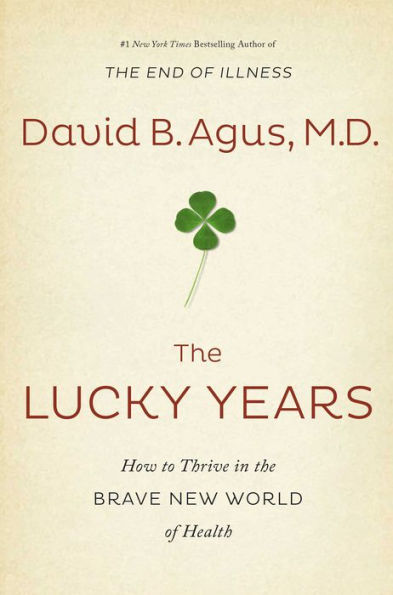

Hardcover
-
SHIP THIS ITEMTemporarily Out of Stock Online
-
PICK UP IN STORECheck Availability at Nearby Stores
Available within 2 business hours
Related collections and offers
Overview
In his first bestseller, The End of Illness, David Agus revealed how to add vibrant years to your life by knowing the real facts of health. In this book, he builds on that theme by showing why this is the luckiest time yet to be alive, giving you the keys to the new kingdom of wellness.
Medicine is undergoing rapid change. In the old world, you followed general principles and doctors treated you based on broad, one-size-fits all solutions. In this new golden age, you’ll be able to take full advantage of the latest scientific findings and leverage the power of technology to customize your care. Only those who know how to access and adapt to these breakthroughs—without being distracted by hyped ideas and bad medicine—will benefit. Imagine being able to get fit and lose weight without dieting, train your immune system to fight cancer, edit your DNA to avoid a certain fate, erase the risk of a heart attack, reverse aging, and know exactly which drugs to take to optimize health with zero side effects.
That’s the picture of the future that you can enter starting today. Welcome to The Lucky Years.

Product Details
| ISBN-13: | 9781476712109 |
|---|---|
| Publisher: | Simon & Schuster |
| Publication date: | 01/05/2016 |
| Pages: | 288 |
| Product dimensions: | 9.10(w) x 6.20(h) x 1.10(d) |
About the Author
Read an Excerpt
The Lucky Years
O wonder!
How many goodly creatures are there here!
How beauteous mankind is! O brave new world,
That has such people in ’t.
—William Shakespeare, The Tempest, act V, scene I
Miss Wanda Ruth Lunsford, twenty-six, must have been thinking about her own mortality the day she reported on a stunning experiment.1 Picture two rats, one old and gray, the other young and vivacious. Now imagine joining them surgically at their sides by peeling away a thin layer of skin and neatly stitching the exposed surfaces together. Through this Siamese-twin-like junction, the rodents are able to share their circulation, pumping each other’s blood and exchanging bodily fluids. Miss Lunsford and her colleagues wanted to see what would happen. Among the rats that survived the unnatural union, the geriatric ones physically turned into their younger counterparts, as if they’d tapped the fountain of youth. The elder rats gained shinier, more colorful fur and clearer eyes, taking on the general appearance of the younger rats hitched to their sides. A four-hundred-day-old rat, more or less akin to a middle-aged man, lived nearly as long as the spry counterpart to which he was attached.
When Miss Lunsford, a nutritionist and graduate student at Cornell University working in the lab of biochemist and gerontologist Clive McCay, shared these results at a gathering to focus on the problems of aging led by the New York Academy of Medicine, no one—not even Lunsford and her teammates—could explain this “age-reversal” transformation. The year was 1955, the same year the Food and Drug Administration approved the polio vaccine, the power of the placebo effect was first written about, Albert Einstein died at the age of seventy-six, and Steve Jobs and Bill Gates were born.2
Miss Lunsford’s procedure, anatomically linking two organisms, had a name by then—parabiosis. But while this wasn’t the first time it had been performed, her explorations were among the first to use parabiosis to study aging. And they weren’t without their challenges. According to one description of the research, “If two rats are not adjusted to each other, one will chew the head of the other until it is destroyed.”3 Of the sixty-nine pairs of rats that Lunsford had helped conjoin in Clive McCay’s lab, eleven died from a peculiar condition that developed about one to two weeks after partners were united; it was likely a form of tissue rejection. But the pairs that survived gave a glimmer of hope for reversing the maladies we all face.
In February of 1956, McCay, Lunsford, and a third Cornell researcher, Frank Pope, published their findings on the procedure’s overall restorative effects in the Bulletin of the New York Academy of Medicine with an apt title: “Experimental Prolongation of the Life Span.” In 1960, the results of Miss Lunsford’s investigations in McCay’s lab culminated in her thesis dissertation.4 But the research didn’t take off as you might expect in light of such intriguing findings. It pretty much sputtered and stalled for the next sixty-odd years. Interestingly enough, you can get a sense of the climate in which these scientists were working by reading a line in the opening paragraph of their paper: “Thus far man has made little progress in [studying aging] because human beings have chosen to expend their energies in improving the supposed comforts of living and methods of warfare.”
Table of Contents
List of Illustrations xi
Introduction: Destiny of the Species: Welcome to the Lucky Years 1
Chapter 1 The Century of Biology: The Cure Is Already Inside You 17
Chapter 2 This Isn't Science Fiction: The Power of Technology to Extend Your Life 37
Chapter 3 The Future You: How Your Small Data in the Context of Big Data Will Save You 71
Chapter 4 The Dawn Of Precision Medicine: How to Manage Its Power and Perils 102
Chapter 5 Take the Two-Week Challenge: How to Measure and Interpret Your Own Data 126
Chapter 6 The Danger Of Misinformation: How to Know Whom, and What to Trust 153
Chapter 7 A Body in Motion Tends to Stay Lucky: The One Supplement You're Not Getting Enough Of 185
Chapter 8 Wonder Drugs That Work: Sleep, Sex, Touching, and Tools to Tame Inflammation 202
Chapter 9 The Butterfly Effect: Get Ready to Flap Your Wings 223
Acknowledgments 239
Notes 243
Index 261
